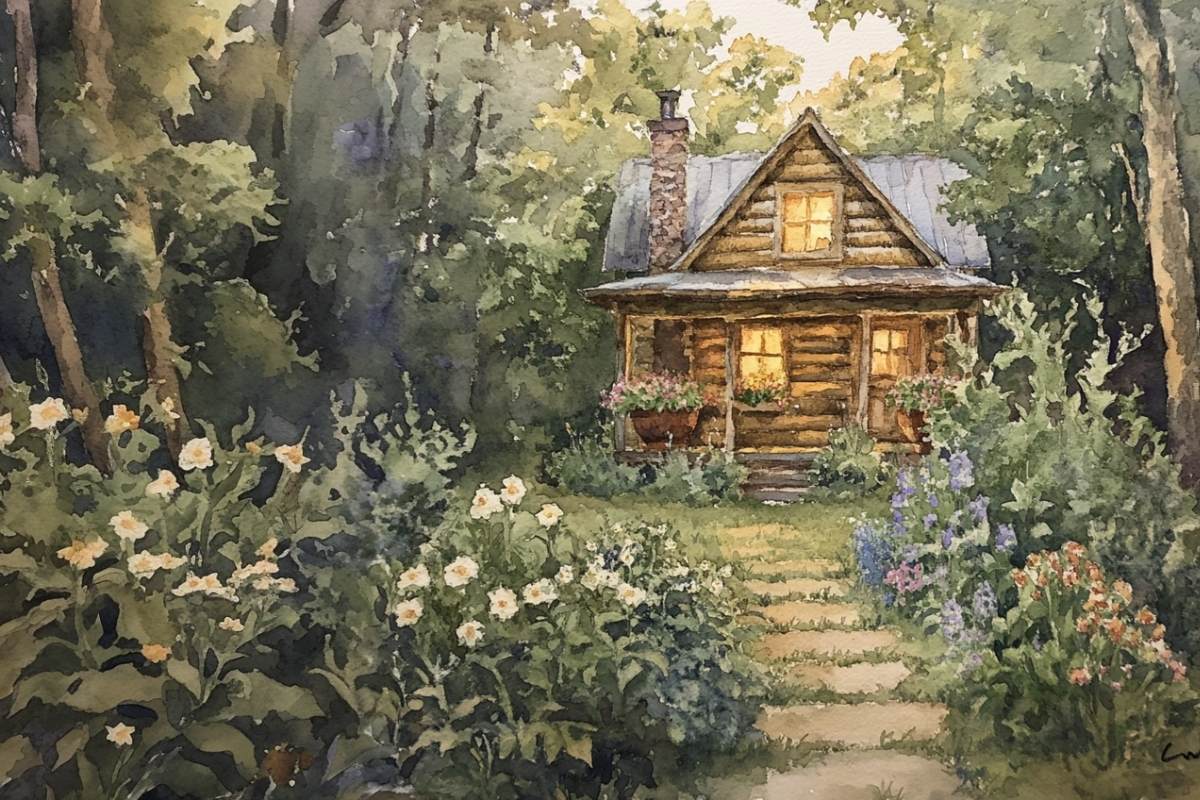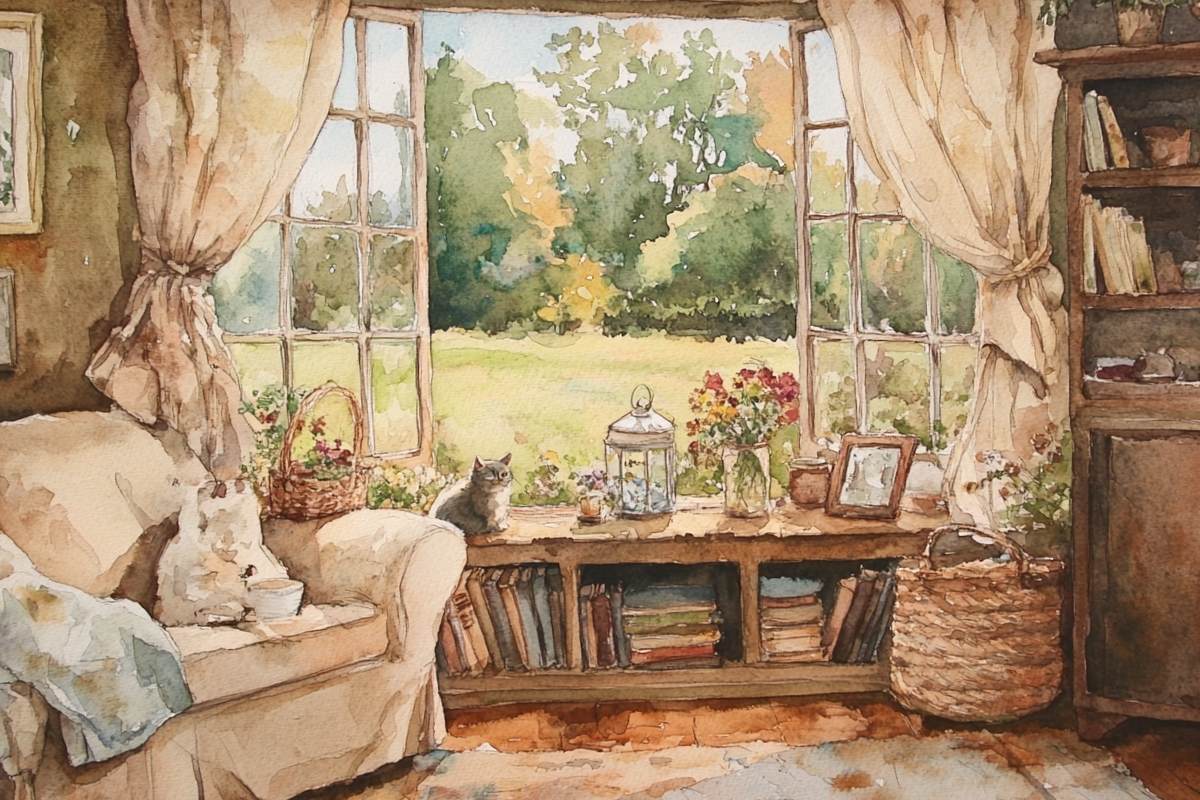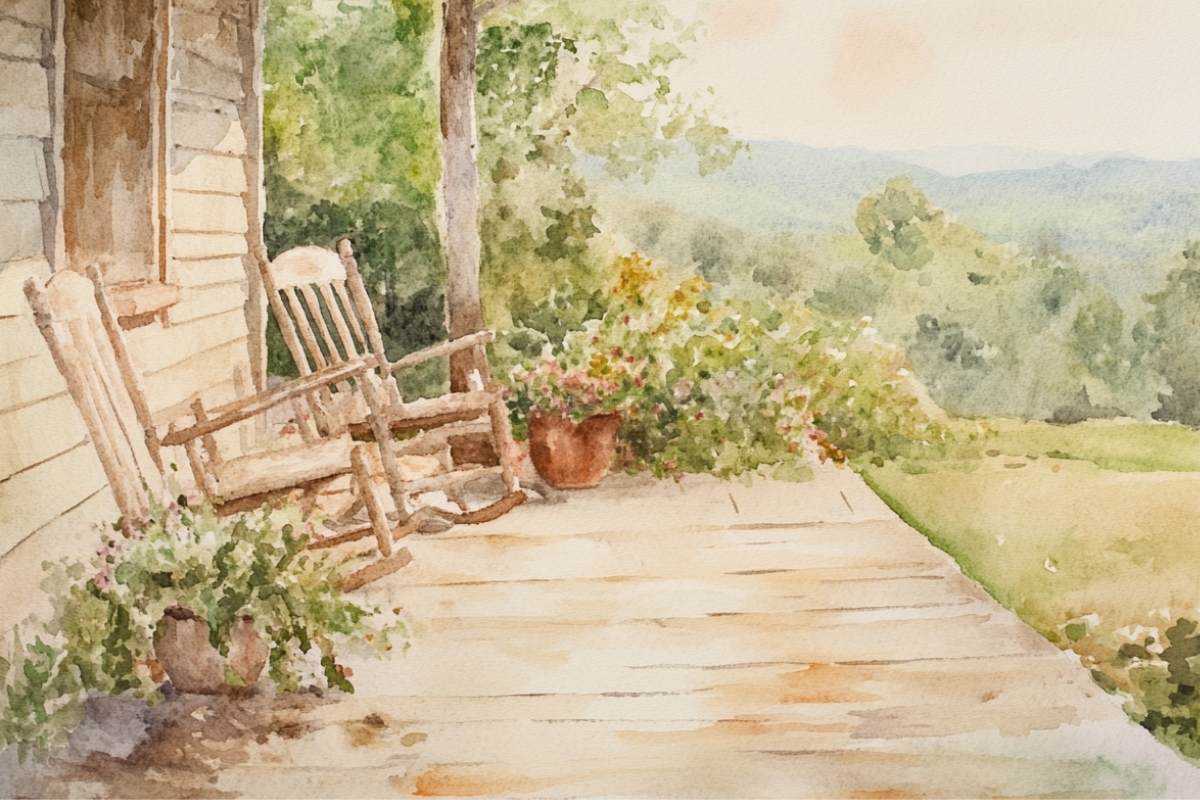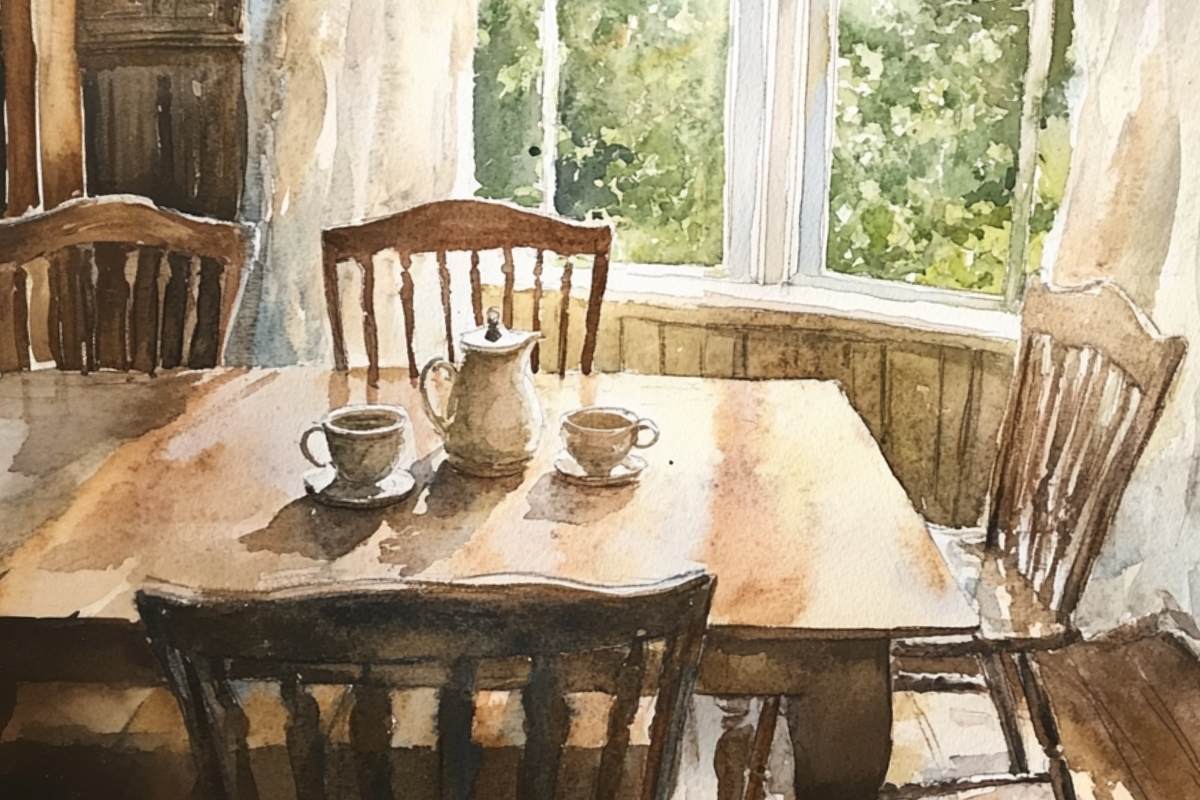Inside: How to use the concept of “peopling” in home decor to give your home warmth and life. This is the secret to a house that feels good.

Imagine a small log cabin with two rocking chairs on the front porch. A candle is glowing in an open windowsill. Fall mums are on the porch in hand-glazed planters.
Now imagine this: a tall, shiny office building emerges from the sidewalk, all glass and steel. Inside is a room with desks placed in a grid. There’s a slightly dusty fake houseplant on the floor.

No logins, No guilt, no Overwhelm
Heirloom Homemaker Email Series

Create a beautiful home life based on routines. We’ll start at the beginning and build you up. Over 2000 women have gone through this and loved it. I promise you will too.
Obviously, one feels welcoming, and one gives you the creeps. But why? Why?
Have you ever heard of the term in architecture to “people” a space? It was used by the architect Donlyn Lyndon as a way to make spaces feel more human, inviting, and alive. It’s not about being beautiful; it’s about the human experience within a space.
I know. This sounds weird and boring. Are we in some kind of strange college lecture? Stay with me. This is anything but boring.
Let’s discuss the principles of “peopling”. It will give your home that magic feel that it’s missing. Really.
What’s Inside
1. Use Human Scale
This principle says: this place was made for people.
This just means creating space that fit people! Why have an oversized couch when you can have one that’s… normal? Why have a two-story grand entryway when you have a…normal room?
- Comfortable distances and things within easy reach. Items shouldn’t be on tall shelves, chairs shouldn’t be gigantic or impossible to get out of, and people in chairs should be able to have a conversation.
- Human ceiling and window height: Standard (8-9 feet) feels balanced in most rooms, High (10-12 feet): can feel formal and less cozy. Techniques like contrasting paint colors (think ¾ wallpaper with white above) or thick moldings can ground a space.
- Human size zones. Even if a room is overly large, human-scaled furniture groupings can solve this problem.
To understand the power of human scale, think of spaces that lack it:
- Enormous foyers in public buildings (this is often done intentionally to show that you in an official space, a subtle message to stand up straight and behave yourself!)
- Overly high ceilings in a home feels emotionally and literally cold.
- A huge place like Costco makes you feel insignificant and like a cog in a machine.

This doesn’t mean you can’t do anything if your home feels too big and impersonal! Adding any of these elements to a too-big space will ground it.
- Indoor plants that are the size of people
- Darker wall paint in rooms with high ceilings
- Tall floor lamp in a corner to visually fill the space.
- A large, plush area rug to ground a seating area.
- Oversized artwork or a gallery wall to break up tall walls.
It is about creating environments that feel comfortable. If you walk in and think “wow, how grand!”, no one be comfortable there.
2. Windows of Appearance
This principle says: a person can appear here at any time.
Everyone (everyone!) has a memory of driving by a house lit up at night and seeing the people within. It creates this feeling of longing. This is an obvious window of appearance, where people are literally appearing in the window, but there are many other ways to do it!

- Open windows
- Curtains
- Windowboxes
- A candle or vase of flowers in the windowsill
- Leaving a light on inside near a visible window at night
It’s not about whether someone is actually at the window! This is about subtle hints of human life and activity that make a space feel alive, even when nobody is currently in view.
Again, examples of when this is missing are often quite effective at making the point.
- Flat office windows. They feel like big side florescent lights using to light up spaces but not much else.
- Mirrored or tinted windows. Creepy.
- Completely shut-off windows. Does anyone still live here? Is the window broken? Are the people alive inside?
This is one of the easiest ones to add to your home, but it’s still so rare because everyone is concerned about sealing things up as tightly as possible for efficiency. Be human and different.
3. Spaces for Planned (and Unplanned!) Interaction
This principle says: more than one person is here!
The seats have to be comfortable and you have to be able to sit down without being asked or feeling weird.
- Wide hallways: wider spaces allow people to comfortably pass each other and potentially pause for a quick chat.
- A chair in the bedroom
- Kitchen islands or breakfast nooks with a few chairs
- Bench or a couple of chairs on the porch or by the entryway.
- Porches and patios

And when a place is not built for humans to actually talk to eat other’s it’s obvious!
- Open floorpans that are “build for entertaining” but have nowhere too put furniture in a natural group.
- Kitchens with no eat-in spaces
- Uncomfortable furniture
- Common rooms that feel so awkward everyone retreats to their bedroom
Interaction spaces are about creating opportunities, not forcing them. It’s about two seats under a shady tree on a hot day, not a dining room table where everyone is forced to stare at each other.
4. Handmade or High-Upkeep Materials
This principle says: a person was here to make this, and they’ll be back!
The craftsman people’s the space with his work. Someone who cares for that item peoples the space with their work as well. If you stumble into a house and a plant that’s alive and a handmade quilt, you can be the humanity in it. If there’s a plastic fern and a polyester blanket, who knows where someone even still lives there
Make sense? Good.

Examples of items that “people” a space
- Handmade items: This one is easy! Handmade pottery, quilts, baskets, embroidered items all work.
- Houseplants, cut flowers, or a well-tended garden: Anything that dies quickly without care reminds the viewer that someone is there. Even a filled bird feeder works!
- High-upkeep materials: A floor that needs to be waxed, copper that needs to be polished, lawns that need edging. They show the evidence of the action, and thus the person who did it.
It’s not about everything being handmade or requiring labor-intensive maintenance. Even a few thoughtfully chosen items, cared for over time, add a human dimension to a space
Low maintenance and artificial things are everywhere now
- Mass-produced décor: Identical items found in many homes lack a personal connection and can make a space feel generic.
- Shiny, sterile, plastic surfaces
- Disposable items
This is easy to add, but easy to mess up
They are all just ways to say “humans made this house, and humans live in this house”. Seems so very simple, but so many items seem to say “machines built this house, and for no particular reason.”
But these principles are, really and truly, the secret to a space that feels deeply personal and alive. Start small… open a window, cut some wildflowers, set a chair at the foot of your bed. It all makes a difference.






Fantastic article. I have a cozy, small house and have tried to implement these type of principles. I can remember my niece, who was about 10 years old at the time and who lived in a “McMansion” saying she loved coming to my house because it felt so homey! 🙂
hi karen! thanks for the kind comment. and YES a house designed solely to impress will never feel like home. so many people realize this too late.
This was a beautiful post. Captured into words so many things that I’ve been experiencing in my own home design journey. Thank you so much for sharing.
hi Christina! thanks so much for the comment. I’m glad it resonated.
I knew I wasn’t crazy to paint my “desirable” vaulted living room ceiling a dark blue. It was dingey and needed painting anyway but I wanted it to feel cozy and not grand. This is an excellent list.
hi Alex! yes human scale for all!
This explains everything I was feeling, but couldn’t put my finger on. Thank you!
hey Julianne, thanks for letting me know this, it’s how I felt too!
Usually little houses are not shown, either, on home design shows. Our house is small, and we care about how it feels and looks. We are making improvements to it that will accentuate the cozy factor. I have a window full of houseplants and just love how they look when the sunlight streams in.
whoever painted these vignettes is such a wonderful artist! I personally would frame and hang these watercolors (?) on the walls in our home. Very lovely 😍
This is very helpful! it’s fun to see the science behind design principles. I knew there was a reason for why I like antiques <3
hey ronni! I’m so glad you liked it. 🙂
Dear Katie,
Thank you for a truly eye-opening article. Now I know why I am repelled by some design programs on TV or particular design magazine – it is because the human touch is completely erased, and everything looks cookie cutter “perfect”.
We are moving from an apartment into small little home, and I am excited to include some of your tips!
hi sherri! thanks so much for your comment! I’m soexcited to hear how it goes, i love seeing things like this in real life. feel free to email me pics any time!
“machines built this house, and for no particular reason”. Ha! Love it! Our house is a 1940s craftsman so it’s impossible to get those light-filled Insta photos but we’ve got cozy in the bag.
Your dining room is lovely!
Thanks! Lucky duck to have a home with built in character!
me also